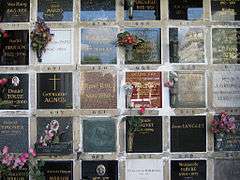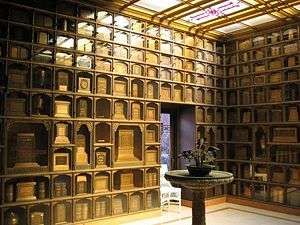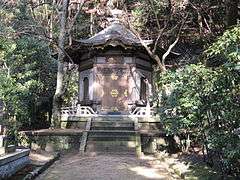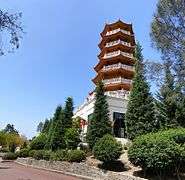Columbarium

A columbarium is a place for the respectful and usually public storage of cinerary urns (i.e., urns holding a deceased’s cremated remains). The term comes from the Latin columba (dove) and originally referred to compartmentalized housing for doves and pigeons called a dovecote.
Background
Roman columbaria were often built partly or completely underground.[1] The Columbarium of Pomponius Hylas is a particularly fine ancient Roman example, rich in frescoes, decorations and precious mosaics.[2]
Today's columbaria can be either free standing units, or part of a mausoleum or another building. Some manufacturers produce columbaria that are built entirely off-site and brought to the cemetery by a large truck. Many modern crematoria have columbaria. Fine examples of these are the columbaria in Père Lachaise Cemetery in Paris and Golders Green Crematorium in London.
In other cases, columbaria are built into church structures. One example is the Cathedral of Our Lady of the Angels (Los Angeles, California), which houses a number of columbarium niches in the mausoleum built into the lower levels of the Cathedral. The construction of columbaria within churches is particularly widespread in the Czechoslovak Hussite Church. An example can be seen at the Church of St Nicolas in Old Town Square (Prague). In the Roman Catholic Church, although traditional burial is still preferred, cremation is permitted provided that the cremated remains are buried or entombed. As a result, columbaria can be found within some Catholic cemeteries.
Columbaria are often closely similar in form to traditional Buddhist temples, which from ancient times have housed cremated ashes. In Buddhism, ashes of the deceased may be placed in a columbarium (in Chinese, a naguta ("bone-receiving pagoda"); in Japanese, a nokotsudo ("bone-receiving hall")), which can be either attached to or a part of a Buddhist temple or cemetery. This practice allows for the family of the deceased to visit the temple for the conduct of traditional memorials and ancestor rites.
Gallery
- Columbarium wall, with flowers, plaques, and empty niches.
 Detail of the columbarium at Père Lachaise Cemetery, Paris.
Detail of the columbarium at Père Lachaise Cemetery, Paris. A modern columbarium in a small German town
A modern columbarium in a small German town Interior of columbarium at Chapel of the Chimes in Oakland, California. Some of the cinerary urns are book-shaped.
Interior of columbarium at Chapel of the Chimes in Oakland, California. Some of the cinerary urns are book-shaped.- Columbarium at Arlington National Cemetery in Virginia. Each niche is covered with a marble plaque.

 A traditional Japanese columbarium at the Takidani Fudōmyō-ō Temple, Osaka, Japan.
A traditional Japanese columbarium at the Takidani Fudōmyō-ō Temple, Osaka, Japan. A modern Chinese-style columbarium at Nan Tien Temple in Wollongong, Australia.
A modern Chinese-style columbarium at Nan Tien Temple in Wollongong, Australia.
Columbarium caves in Israel
In the Bet Guvrin area several series of large caves dug into soft rock were found. There were several theories about their original use, for ritual burial, for growing pigeons to be used for ritual sacrifice, or for raising pigeons for fertilizer production. One such cave had been covered by an earthquake close to the time of its original usage, and had no signs of secondary usage. This cave had no ashes found in it, but also no pigeon droppings.[3]
Among the archaeologic finds on Masada, a columbarium tower foundation remains.
See also
References
- ↑ Toynbee, J M C (1971). Death and Burial in the Roman World. Johns Hopkins University Press. pp. 113–118.
- ↑ Ancient Roman underground columbariums included: Columbarium of Statilii, Columbarium of Volusii, Columbarium of Livia, Columbarium of Pomponius Hylas, Columbarium of Lucius Arruntius, Columbarium of Iunius Silanus, Columbarium of Nero Claudius Druscus, Columbarium of Marcella, Columbarium of Carvilii, Columbarium of C. Annius Pollio, Columbarium of Caecilii, Columbarium of Passienii, Columbarium of Bruttii, Columbarium of L. Caninius Gallus, Columbarium of L. Abucii, Columbarium of Q. Sallustii. Further reading in Pavia, Carlo. Guide to Underground Rome: From the Cloaca Maxima to the Domus Aurea: the Most Fascinating Underground Sites of the Capital. English translation by Darragh Henegan. Rome: Gangemi, 2000. ISBN 88-7448-994-3
- ↑ Bet Guvrin National Park at the Israel National Parks website, and The Land of 1000 Caves.
External links
| Wikimedia Commons has media related to Columbaria. |
- Photographs and commentary on ancient Roman columbaria
-
 "Columbarium". Encyclopædia Britannica (11th ed.). 1911.
"Columbarium". Encyclopædia Britannica (11th ed.). 1911.